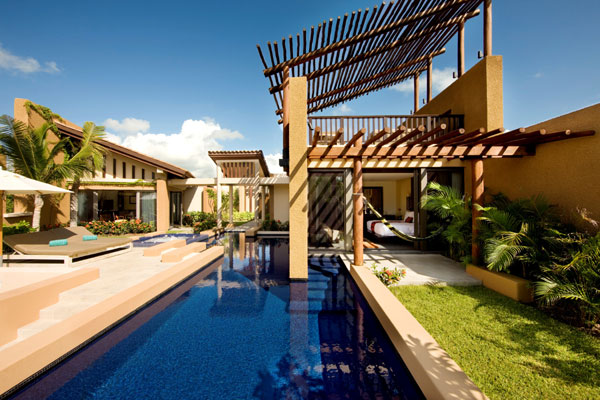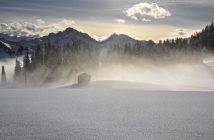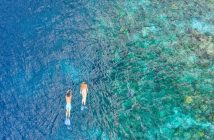There are two roads from Cancun to Chichen-Itza. The first, the 180, takes you through quiet villages at a gentle 60kph. The other, the 180D, the one we found ourselves on – and not by design – was a dual carriageway, straight as a die, through scrub jungle and without a single stopping point for 150km. It’s a road used by freight trucks, farmers, and accidental tourists, evidently. We were often the only vehicle for miles as far as we could see either end. 180. 180D. It’s a simple mistake to make, particularly when signage meant missing a turn to Merida and our somehow turning back into the airport. And the small scale map I’d bought in London seemed adequate when there only looked like 3 roads across the whole state. Such hiccups are all part of the fun, though. What isn’t part of the fun is dismissing a fuel stop before turning onto said straight dual carriageway and passing a sign showing with a petrol pump and “148km” written beneath it. My previous concern at noticing how swiftly our Chevy’s fuel gauge diminished soon turned to alarm and I considered turning back to refuel but there being no evidence of ‘retorno’ points meant that we were now committed and, evidently, facing our imminent doom.
![]()
We pressed on, with visions of our abandonment; our car left roadside and 20km further up the road our sun-baked bodies, just moments from civilisation, being pecked at by nonchalant buzzards I’d suddenly noticed circling overhead. The aircon malfunctioning, I noticed Mrs L downing water like it was going out of fashion. “D’you think you could go easy on that? We might…need it.” It’s curious how panic works. The two commodities we needed in this situation seemed to be the two we desperately flaunted. And rather than slow to a fuel-conserving 60kph, I found my foot pressed firmly to the floor, the speedometer climbing past 120, in the misguided belief I could get to the fuel stop quicker.
I began calculating fuel averages, taking 10km stretches at difference speeds and seeing how far the needle moved. “D’you think you should slow down a bit” Mrs L frowned, taking another slug of water, “it would be nice to see the scenery.”
“Confound the scenery,” I barked back, “it’s petrol we need! And stop drinking so much water, for crying out loud…why is there no-one on this road?!”
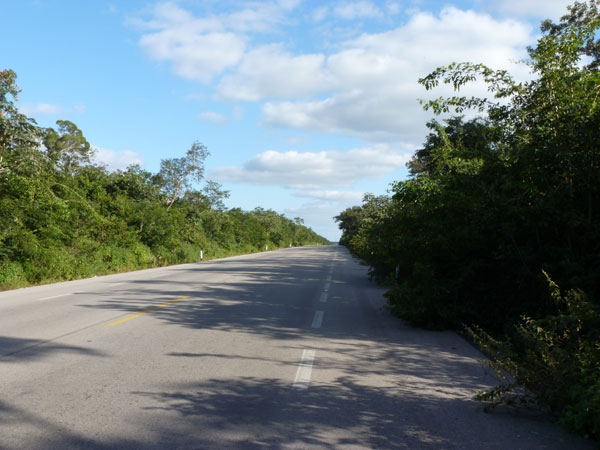
I needn’t have panicked. Few fuel stops there may be in Mexico but as Simon, the owner of a villa we would be staying at later on, remarked, “You always have just enough for your journey.” It’s as if they’ve worked out exactly where to place the gas stations. The other piece of advice he gave me was to never speed. My assumption that the Mexican authorities might be fairly relaxed about that sort of thing was in error. Still, it did mean that we beat the three hour estimate for the drive by over an hour, the most fearful incident being unexpectedly pulled over by the police at the state border. Was this normal? Did we look suspicious? Again, Simon’s words the next day reassured me that all was well but with the officer porting his machine gun and asking me to step out of the car, at the time my heart was thumping in my throat. He checked every bit of paperwork we possessed, at one point asking me what “[Great Britain] and Northern Ireland” was doing in my passport? Dear God, is it illegal to be Irish in Mexico? How could I not know this? I considered showing him some ‘financial’ paperwork. This, however, would have made matters worse, I later learned. All was legitimate, on both our counts, and we were soon turning off into Valladolid, and a much needed fuel stop. The awkward semantics of my pidgin Spanish and the diminutive Mayan pump attendant’s lack of English, while confusing our exchange, gave me a comfortable rise as I realised we had now definitively left the tourism of the coast behind and, as we drove into town, here was the Mexico I had imagined. No resorts, no homogenised urban morass, no Starbucks, but a laid back collection of small, square, pastel-painted buildings, tumbledown shops and cantinas with plastic tables and large bright Coca-Cola signs painted across their walls.
![]()
We pressed on to Chichen-Itza, this time on the 180, at a leisurely 60, and with plenty of scenery to view and villages to stop at, should we have wished. Our destination, however, was our motivation this time. Having left early to beat the expected crowds, we deflated slightly on seeing the first of the tourist coaches from Cancun arriving as we pulled into the car park.
Evidently the Mexican Tourist Board does seem to organise itself rather well, we found here pretty much every official things you’d expect from heritage sites in the UK, from well-stocked gift shops to the café…and a number of unofficial things, too; guides touting for business and every other square foot of pathway populated by tradesmen hawkers all offering the same thing, “Sombrero, senor?” “No, thank you” gets a bit tiresome the 34th time. We walked what was a well-planned route to give the best ‘reveal’ to the main temple; a glimpse through the trees at first and then, into the clearing, it appeared before us in its full glory. This is what you think of when you conjure up an image of the Maya.
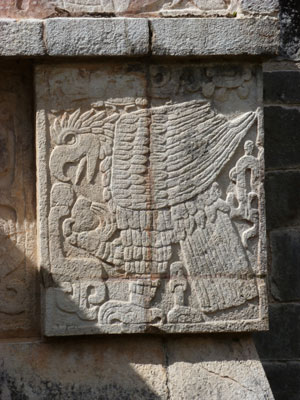 The whole complex is an impressive site; a thousand years old and substantial areas intact, it took a good couple of hours to cover. The Temple of Kukulkan, the centerpiece, being undoubtedly the main event, riddled with Mayan reliefs and time symbolism, from the number of steps (365) to their grouping, to its orientation. All in the name of celestial observation and death occultism. And the accuracy of their findings is staggering, it’s no wonder the world is watching and waiting for the 21st December 2012.
The whole complex is an impressive site; a thousand years old and substantial areas intact, it took a good couple of hours to cover. The Temple of Kukulkan, the centerpiece, being undoubtedly the main event, riddled with Mayan reliefs and time symbolism, from the number of steps (365) to their grouping, to its orientation. All in the name of celestial observation and death occultism. And the accuracy of their findings is staggering, it’s no wonder the world is watching and waiting for the 21st December 2012.
The other highlights included the Platform of Skulls, bedecked with reliefs of, well, skulls, and eagles eating human hearts; the Platform of Venus with its discarded stone phalluses piled under the trees nearby; and the Great Ball Court, known for its well-preserved reliefs but, alas, closed for restoration work on this occasion. Further exploring revealed the Observatory, Nunnery and Church – all largely misnamed by the Conquistadors who found them, who opted to call them what they looked like rather than what they were used for. Speaking of which, the name “Yucatan” is Mayan for “I don’t understand you”, the supposed response they gave to the Conquistadors when trying to ask what this land was called. Chichen-Itza is a must on the Mayan trail, a great introduction to their culture and as we drove on I felt privileged to have been to one of the ‘new’ Seven Wonders of the World.
Merida
And so to Merida, the capital of the Yucatan. Alas, time now pressing we had to skip a visit to the definitive cenote – the one you see in all the pictures – in favour of reaching our next stop in time…not least because we didn’t know where we were going.
The route to our accommodation gave the unexpectedly built-up Merida a bit of a disappointing introduction, we were circumventing the city around the ‘Periferico’ – their equivalent of the M25 – and its views of factories, shopping malls and the more run down parts of town. Taking our exit to Calle 59, and things began to improve on sight of the Century Park and the more elegant facades of buildings towards to the centre of town. One of which was Villa Merida, our destination.
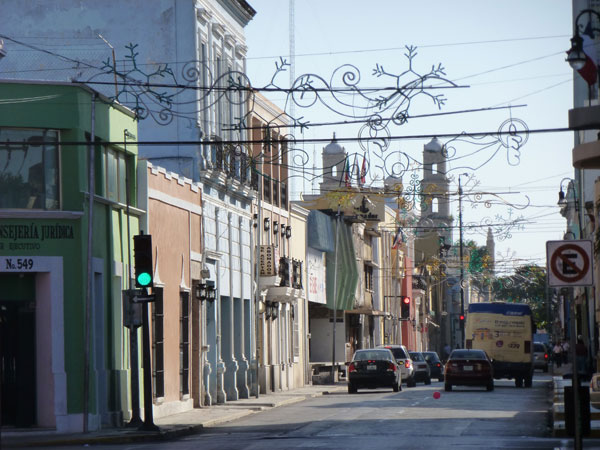
Rapping a substantial brass knocker on its barn-sized doors, we were met by Luis, the manager, as he heaved open the door and led us inside. Immediately cooler as we entered its polished hall, inside is a beautiful former nobleman’s villa with bedrooms surrounding a central cloistered courtyard complete with obligatory fountain and foliage. Once rundown it has been lovingly restored with original features retained where available, from the floor tiles to framed patches of original paintwork on the walls uncovered during its renovation. The bedrooms featured the highest beamed ceilings I’d ever seen and thick, solid oak doors that must be 10foot high themselves. A four-poster with a regally-carved headboard completed the picture of colonial grandeur and yet, there being only seven rooms, it made this stay a delightfully homely alternative to the larger hotels and haciendas on the rest of the trip.
Once settled and given the guided tour we then wandered the twenty minutes down Calle 59 for a wander around the Plaza Grande. While mainly boarded up for renovation work in anticipation of the 2012 festivities we did encounter the beautiful Casa de Montejo. Built in 1549 by the son of the conqueror of Yucatan, its façade is resplendent with Renaissance artistry. That era and its spoils resonate no more than over its entrance where worn stone carvings of Conquistadors stand over the gaping heads of the vanquished natives. Today it’s principally a bank but also opens its doors as a free walk-through museum retaining a beautiful collection of Rococo furniture and fittings, gathered by the Montejo family through the centuries – only moving out in the 1970s. Our circuitous walk ended at an artisan market where once again, without fail on every trip, I was fleeced out of half of our budget, this time by a persuasive hat-seller peddling me a panama I neither needed nor wanted.
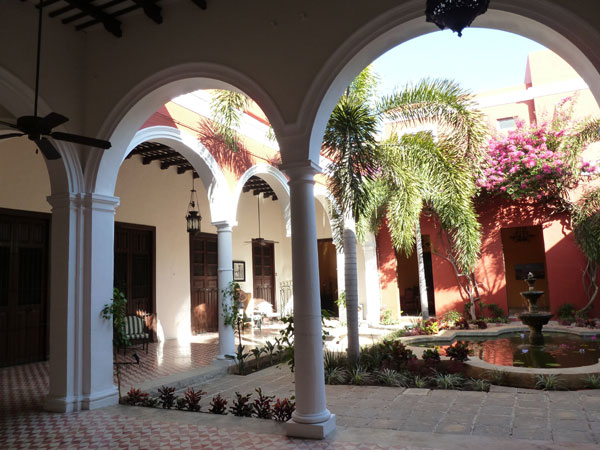
To conclude our first night in Merida, we stopped at Casa de Frida – a restaurant quite plainly a shrine to Frida Kahlo – found by following some American tourists following Fodor’s. It proved unremarkable, however, with the exception of Mrs L’s first taste of mole sauce and a disinterested pet rabbit loping about our feet.
Celestun
We took Luis’s recommendation for breakfast, which came with the caveat “if you have courage”, and made our way to Santiago market, tucked behind the church in the district’s main square. Merida is made up of what were originally a collection of small villages, each with a square and a church, which have since been swallowed up amid urban expansion, but each district still retains its own character. The night before, as we passed it, the square on our way back from Frida’s, it was quiet and uninviting. This morning, however, it bustled feverishly; fruit and veg vendors filled the centre, and the corn grinders and taco machines cranked and clattered around the periphery. We avoided the first, empty eaterie and instead bore right to the middle of the melee to a semi-clean table amid the locals, unphased at the arrival two out-of-place but intrepid gringos. We ordered pescado and carne taquitos from the energetic waiter – which were delicious to the extent I ordered two more. What wasn’t delicious was the curious horchata drink I picked from the menu, largely because I didn’t know what it was. A Mayan speciality, I later found out it was a coconut-flavoured rice drink.
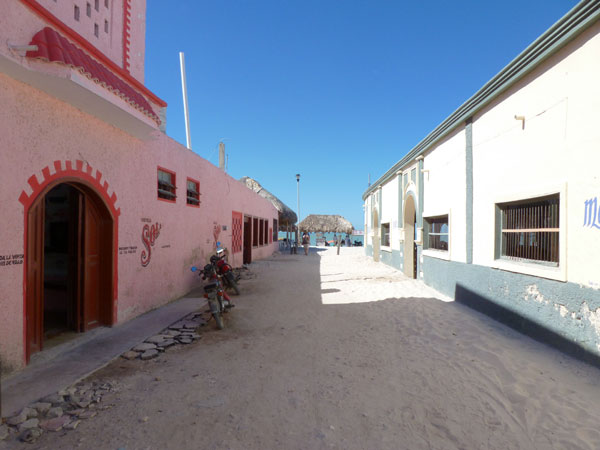
The main event today was the drive out to Celestun, a sleepy (are there any that aren’t?) fishing village on the western coast of the peninsula and home to a substantial ‘biosfera’ nature reserve. A morning’s drive west, through small colourful towns, all so characteristic of one’s imagination with palm-tree’d plazas, baroque churches and the token stray dog, I noticed, too, that most of the traffic was made up of tricycles, modified to carry either passengers or cargo, and the odd motorized tuk-tuk.
Through the last village, the final 50km shot us straight through the bush and into the biosfera region and as we arrived in Celestun one stark observation was that this was a town in the midst of upheaval. Every street had been pulled up in order, it would seem, to lay new plumbing. In spite of the onset of industrialization, Celestun certainly seemed to retain its lethargic charm. If there was ever a definition of ‘sleepy fishing village’, this was it. In fact, so sleepy was this town as we walked on to the beach evidently we were the only ones awake. Certainly, we seemed to be the only ones there. A lone tout grabbed our attention offering us a boat trip to see the flamingoes – what the biosfera was famous for – for 1400 pesos. “I can get a hat for less than that,” I remarked and chanced upon bartering. He offered 200 each…if we could find four others to share the boat. Four other people? I looked around. A lone, hunched old lady shuffled a broom across a deserted restaurant nearby. “There will be more people,” he assured us, so we settled under one of the nearest palapas and ordered lunch. No sooner had we ordered a mountain of seafood ceviche and a fried fish – literally a whole fish immersed in oil – than three, four, five more people appeared on the beach and were escorted to a boat before we could even protest. By the time we’d wolfed down our lunch and commandeered the tout we were the only two on the beach again.
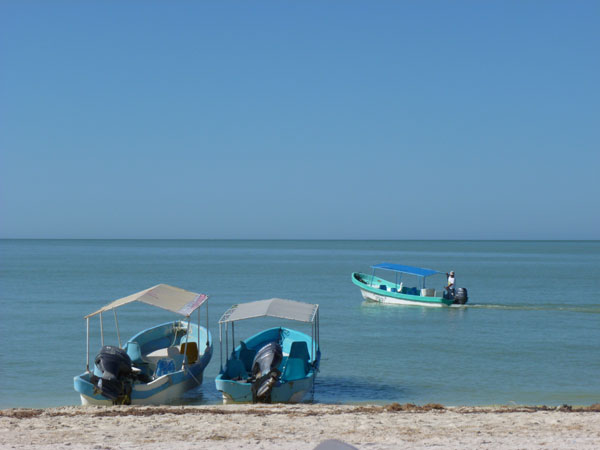
The wait to fill another boat wasn’t too long, however, and we were soon away, at an unbelievably swift pace for what, from the shore, looked like a steam-powered fishing boat. But, like something from a Bond film, this docile-looking vessel harboured an outboard that could take down a powerboat and we belted along the shoreline passing – and scaring, no doubt – clusters of pelicans and petrels. Looping into the lagoon and running alongside mangroves we coursed up the rust-coloured river and soon approached a curious site; between the distant green tree line on the opposite bank and the murky sand-coloured water of the lagoon, ran a thin line of pink. As we got nearer, the pink took shape and we realized it was the flamingo colony. Sebastian Vettel unrelented at the wheel as we bolted toward them until, at the very last moment, he brought the boat to a halt, just yards from the flock. They seemed such sedentary creatures, a handful only being startled into flight as we came by.
My initial apathy at this trip soon turned to awe as we watched this sea of orangey-pink go about their business. Standing in less than about a foot of water, about 30,000 made up the colony, Vettel told us, and we were in luck, too, they were only here for two months of the year. They seemed to move as one as we drifted toward them, casually parting and reforming as a school of fish or flock of sheep might, the odd one clumsily, yet somehow gracefully, taking flight. It was, in its truest sense, a sight to behold.
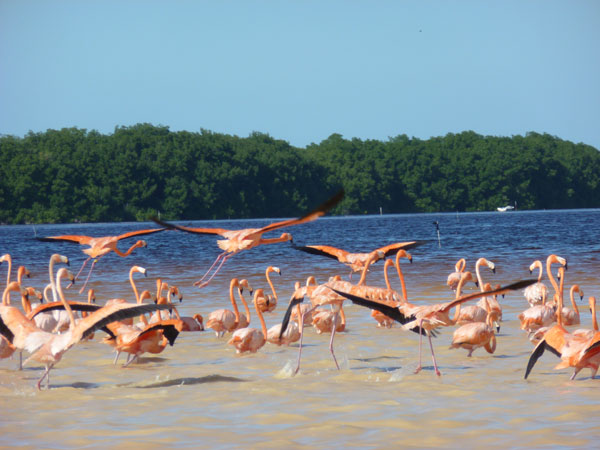
Dinner that night was a delightful affair, enjoyed in the spot-lit garden of the villa and consisted of more Yucatecan specialities, namely chicken in tamarind sauce, and cooked by Luis himself. I couldn’t say whether he would be the chef in normal circumstances but, given the villa was in its closing stages of renovation, it accounted for both the lack of guests and the special treatment. Not least of which involved drinks with Simon, the owner, before supper. A confident, outgoing Englishman, younger than his years – the villa was a passion project for his love of Mexico and Merida, particularly, and who’s years of experience in the country provided a fascinating insight into the city and Yucatan’s culture, economy and future prospects, touching particularly on the predicted tourist boom expected for the end of the Mayan calendar in December 2012. Clearly, we had come at the right time.
Merida to Campeche
We bade Luis a friendly goodbye and were back on the Itzacs, the arterial road from Merida’s centre, heading south to Campeche. Another heart-stopping moment at a police stop just outside the town’s border but this time slightly reassured by Simon’s words the previous night that a British passport means everything and, besides, they’re really only looking for guns, such is their desire to keep the city safe. It says a lot for the continued Mayan governance that the drug cartels blighting the rest of the country are not tolerated in the Yucatan. Evidently, though, we’d just have to expect these spot checks, particularly with our out-of-State plates.
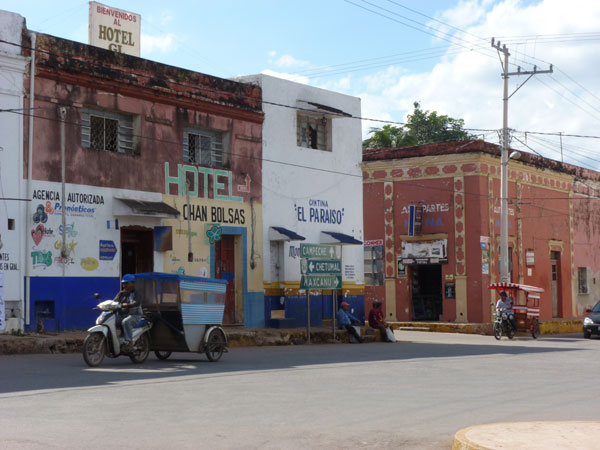
The need to find a cenote now ever-pressing we pulled into a small town off the 180 called Chocol, having seen a sign for Cenote San Ignacio. The signs ended there, however, and we nearly gave up touring the back streets, until finally seeking directions, we found it. Here, in the grounds of a garden restaurant where livestock ambled among the tables and Lisa Stansfield boomed from next door, we purchased a ticket from a wrinkly but enterprising matriarch who didn’t speak English – or chose not to – and descended a few steep steps into possibly the smallest cenote on the peninsula. Fate must be playing us for fools. I mean, really. It was about as big as a bath. Were it not for being a refreshingly cool respite from the heat outside, I was beginning to think these things didn’t actually exist.
The drive to Campeche proved hot, unrelenting and uneventful. In the process of being widened for what was signposted ‘vivir mejor’ (‘better life’?), presumably part of an overall modernization project for 2012, road works stalled proceedings every few miles. We decided to bypass Becal – the place they make hats (I already had one, after all) – in favour of a stop in Hecelchakan for lunch and what the guide book told me was a regional speciality, rellenos negros, that people came far and wide for. Alas, all the main stalls outside the church had stopped serving so we contented ourselves with an empty outdoor eaterie of makeshift tables under tarpaulin, tucked behind the market. No amount of rhetoric about rustic charm could have disguised the fact that this was anything but a brackish backwater. And the rellenos negros complimented that. This was one regional speciality I think I could have done without. Supposed to be chicken and pork stuffing in a thick black broth of chili and beans it had the consistency of silt. We didn’t stay long.
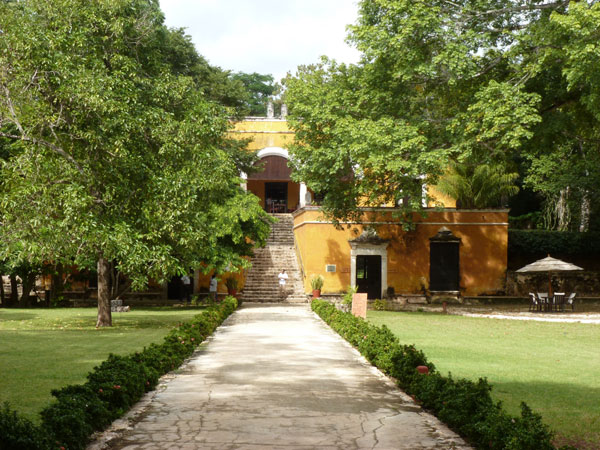
Our destination, Hacienda Uayamon, was near a tiny village of the same name about 25km outside Campeche and through another village named, amusingly, China. This would provide continuous entertainment over the next day or so as we ventured into town and back, “How do you get to Campeche from the hacienda? Go through China.” At one point, at a police checkpoint outside town – now, simply, part of the routine – having an amusing exchange with a police officer over its pronunciation; “Excuse me, officer, is this the way to China?” “Shina?” “Indeed, China. Is China this way?”
But I digress. Tucked into semi-jungle, Hacienda Uayamon quite remarkably retains all its ruined, mouldy, moss-covered features back from the time of its abandonment and integrates five star luxury within. A former rope-making farm, the complex once supported workers with their own housing, and even a church, before entering decline after an uprising in 1913 and desertion in the 1960s. A huge Ceiba tree and the building’s imposing yellow façade greet you on arrival as you come up the drive, but the real highlight is the pool, which has been integrated into the ruins of the warehouse. Our accommodation, set amid the foliage, is one of the former workers’ cottages. Nothing to look at from outside it’s beautiful within, with its pitched beamed ceiling and comprising a substantial bedroom with four poster, and even a hammock to stretch between walls. Then, through wooden doors, down a short hall to a double bathroom and sunken bath. Oh, and a day bed on the terrace outside. Gorgeous. If a bit damp, admittedly, but we were practically in the jungle, after all.
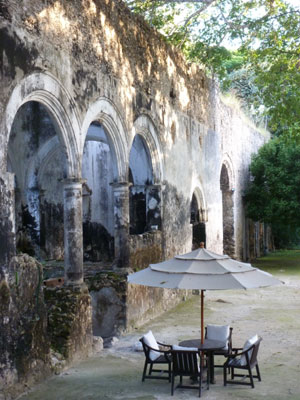 After the drive all that was required was a dip in that pool and a delightful welcoming foot rub and as the sun sank through the branches of the ceiba tree we got ready for dinner. Set high on the hacienda’s terrace, to the sound of clicking geckos and a nearby bat, we tucked into yet more Mexican specialities – I could never get bored of this cuisine – with chicken and lime soup followed by shark meat tortillas drenched in tomato sauce and washed down with a lovely but shamefully over-priced Mexican Sauvignon Blanc.
After the drive all that was required was a dip in that pool and a delightful welcoming foot rub and as the sun sank through the branches of the ceiba tree we got ready for dinner. Set high on the hacienda’s terrace, to the sound of clicking geckos and a nearby bat, we tucked into yet more Mexican specialities – I could never get bored of this cuisine – with chicken and lime soup followed by shark meat tortillas drenched in tomato sauce and washed down with a lovely but shamefully over-priced Mexican Sauvignon Blanc.
Campeche and Edzna
Woken by a very exotic dawn chorus, which continued through an early breakfast, on today’s agenda: Edzna, a substantial but lesser known Mayan site 40km east of Campeche. Unlike Chichen, it was blissfully deserted but for a handful of workmen, a pair of backpakers and a dead snake encountered on a path. It is, however, no less impressive. In fact, more so, for having the place almost entirely to ourselves. A huge plaza is fronted by an acropolis – this time allowing us access to climb – on which sits several temples including the majestic Edificio de los Cinco Pisos, literally ‘Five-Storey Building’. Some relief work to the base isn’t quite as good as the stucco masks preserved to the base of the nearby Templo de los Mascarones but with all of these buildings in such close proximity, the scale of some of them and the degree of preservation it feels more immersive than its Yucatan forebear. And it’s hard to believe that while the Mayans were experiencing the apogee of their civilization we were in the Dark Ages.
Fortunately, Uayamon was not too far so we opted for a pit stop and a dip in that pool before planning our afternoon in Campeche. By 3pm, with hunger encroaching, we set off for the town but what should have been a half hour journey became over an hour with half a dozen wrong turns and inadequate maps. It didn’t help either that signage was nearly non-existent and the roads were barely marked. On the plus side the one police check we encountered waved us on. Nevertheless, our intended snack in the main market was thwarted as they’d all closed up the time we arrived. Still, we had a pleasant stroll around the colourful old town before eventually snacking on some churros from a street cart and watching a stunning sunset from the Malecon, the waterfront boulevard.
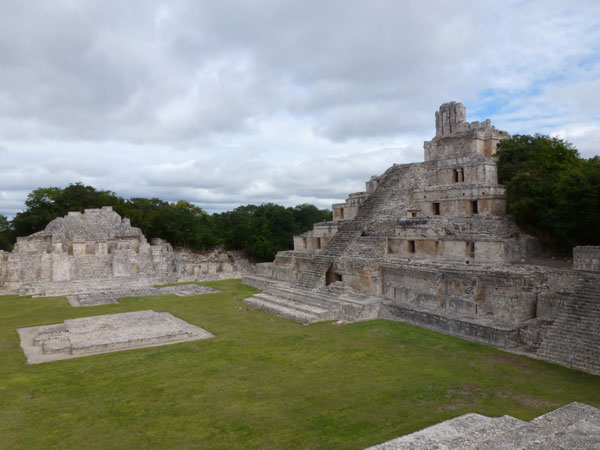
Whist we didn’t, alas, see much of Merida we concluded that we ultimately preferred Campeche. A former Mayan trading village named after Lord Sun Sheep-Tick (really) it became overrun by Spaniards in the mid 16th century and, in turn, marauded by pirates until, after a particularly savage attack in 1663, the Spaniards eventually constructed the fortifications and bastions which now part-surround the old town. Speaking of pirates, we noted out to sea the Lorencillo, a recreation sloop giving tourists a taste of the pirate life – too tacky for us, admittedly, but it looked tremendous against the backdrop of the sunset.

